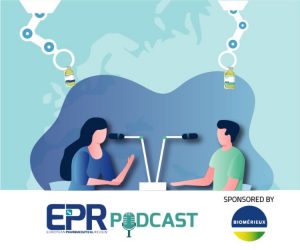
European Pharmaceutical Review podcast
EPR Podcast Episode 7 – Collaboration in ATMP development – Jérôme Larghero and Julien Textoris, bioMérieux

Collaboration has been a huge part of the COVID-19 pandemic response, but it is also hugely important in the development of various other therapeutics. In the second episode in our advanced therapy medicinal products (ATMPs) series Jérôme Larghero, Director of the Department of Biotherapies and the MEARY Center for Cell and Gene Therapy in the Hôpital Saint-Louis, AP-HP, and Julien Textoris, Vice President of Global Medical Affairs, Immunoassays and host response at bioMérieux, discuss the importance of collaboration between academia and industry in the development of ATMPs.
What is the MEARY Center?
The MEARY Center for Cell and Gene Therapy is the ATMP manufacturing centre of the Assistance Publique – Hôpitaux de Paris (AP-HP) – the university hospital trust operating in Paris and its surroundings. AP-HP includes 39 hospitals and is the largest hospital system in Europe. The MEARY Center offers the services, skills and contract development and manufacturing organisation (CDMO) capacities to develop cellular immunotherapies and regenerative medicine. “The centre is first an academic centre dedicated to cell and gene therapy, and to collaboration for projects that are run both with academic and industrial partners,” explains Jérôme. He added that the role of the centre is to develop processes for the manufacturing and QC of cell and gene therapies of various types and for different indications, to allow collaborators to conduct clinical trials of investigational products.
With several hundred cell and gene therapies currently under development worldwide, what limitations are hindering the development and application of cell and gene therapies?

Jérôme Larghero, Director of the Department of Biotherapies and of the MEARY Center for Cell and Gene Therapy, Hôpital Saint-Louis, AP-HP
Jérôme explains that many of the manufacturing and QC problems faced by pharmaceutical and biopharmaceutical developers are also faced by cell and gene therapy developers: “we face exactly the same issues when we have to think about which kinds of quality control, when we have to put in place this quality control and how we have to perform both the manufacturing, quality control and the release of product.” He continued that as with any pharmaceutical, manufacturing for ATMPs must be based on ensuring that, at the end, they deliver a safe product for patients.
Jérôme goes on to explain that because ATMPs have huge heterogeneity, they require specialised manufacturing and QC, which is a challenge. “We all know that two healthy donors are different, because their cells are different. Regardless, at the end, we are supposed to have robust, reproducible processes… much is based on how you qualify your product, and thus which kind of quality control you will put in place,” he remarks.
Another challenge limiting ATMP development and manufacturing is the sheer number of quality control tests required and the time taken to perform these processes, as well as the cost of such testing and its impact on product pricing and accessibility. Jérôme describes how both virologic and microbiological testing are required to ensure products are safe, but microbiological test results take seven to 10 days to come back. Additionally, cellular attributes must also be assessed. The result is that, dependent on the type of product and its specifications, between five and 15 different QC tests are needed with five or 10 in-process controls. Jérôme noted that gene therapies typically requiring a larger number of QC tests than cell therapies.

Julien Textoris, Vice President, Global Medical Affairs, Immunoassays and host response, bioMérieux
He also explained how this impacts product cost, using chimeric antigen receptor (CAR) T-cell therapy as an example: “It is more complex than saying for one batch it is 10 percent of global manufacturing cost, because we forget that when you perform one QC, you are supposed to put in place all the qualification and validation of your methods, which takes a long time… So I think all the costs of developing your quality control should be included as well, so the quality control could represent somewhere between 10 to 20 percent of the cost of the whole drug product.”
“The question is whether we will be able to put in place new technologies to have [microbiology] results in maybe 24 or 48 hours, which will allow the lots or batches to be released much quicker,” states Jérôme.
What can be done to expedite manufacturing and release of ATMPs?
From patient sampling to reinfusion of a CAR T-cell therapy is at least a month long process, according to Jérôme. Included in this timeframe is 15 days of manufacturing and up to 10 days for QC testing such as microbiological analysis. He added that this period can be extremely difficult for patients, who are typically critically ill and on a third or fourth etc line of treatment, to wait and be treated in the meantime. Julien explains how this puts an emphasis on time to result as a critical issue, because patients’ diseases may progress during the manufacturing and QC period.
Jérôme adds that it is not only by improving time to QC test result that this timeline may be shortened, through optimisation and industrialisation of the manufacturing process this time could be further reduced. He describes two potential ways of doing this:
- implementing new technologies or new equipment to try to manufacture quicker and safer, for example, by using bioreactors rather than plastic flasks to support more cells and greater product quality
- for CAR T-cell therapy, limit the ex vivo expansion phase, delivering the cells into patients earlier and allowing them to expand within patient – the safety of which must be further explored first.
With such developments, research suggests that manufacturing could be reduced to one or two days, states Julien, meaning the sterility testing would be five times the length of manufacture. Evidently, developing QC is also important to overcome this issue.
To learn about all this and more, tune in to this podcast!
Please join the conversation and leave your thoughts in the comments – we love hearing your feedback – and look out for our next episode coming soon!
The post <em>EPR</em> Podcast Episode 7 – Collaboration in ATMP development – Jérôme Larghero and Julien Textoris, bioMérieux appeared first on European Pharmaceutical Review.